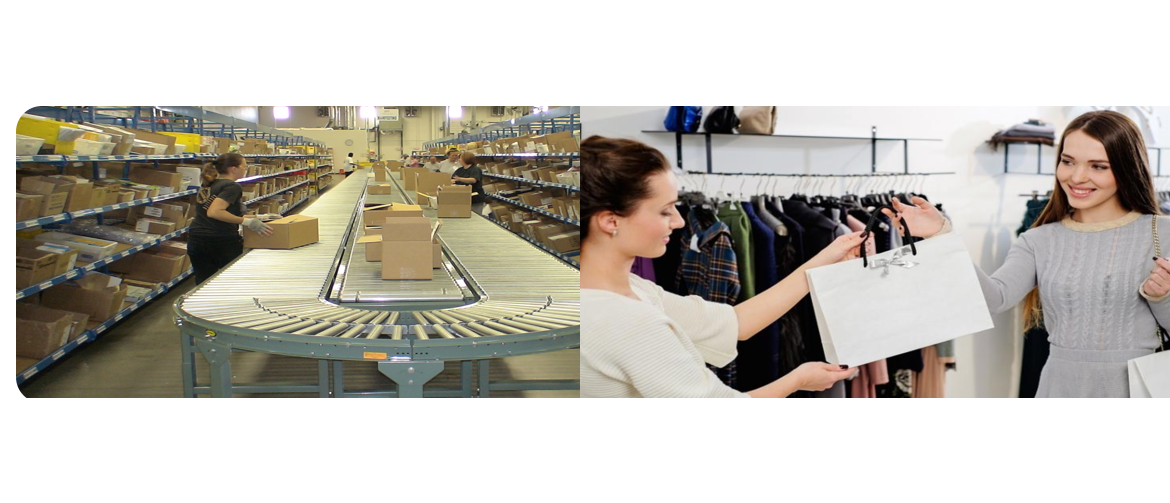To design and develop a successful and cost-effective Omnichannel Supply Chain Logistics & Distribution Setup, Companies should focus on two key areas:
Key Area 1: PERFORMANCES & COST EFFECTIVENESS
1.1 Seamless inventory visibility and optimisation
1.2 Flexible dynamic set-up
1.3 Localization and Real-time connection
Key Area 2: LAST-MILE EVOLUTION
2.1 Store fulfillment and micro-warehouses
2.2 Enhanced delivery models
2.3 Introduce value-added services
Key Area 1: PERFORMANCES & COST EFFECTIVENES
Omnichannel Supply Chain Logistics & Distribution Setup has to orchestrate flexible fulfillment options across channels, this requires much greater flexible Logistics infrastructure.
1.1 Seamless inventory visibility and optimisation
It will become the norm to share inventory at the store and distribution center for online order fulfillment to be able to dynamically allocate and fill orders across the Omnichannel enterprise.
One of the core challenges in this transition is real-time inventory visibility of the merchandise in retail stores.
Unfortunately, as of today, inventory accuracy in traditional retail store is a big issue even if todays, technology can help to address this issue.
Inventory Optimisation is at the same time cause and effect of an Omnichannel Supply Chain Logistics & Distribution Setup transformation.
1.2 Flexible dynamic set-up
Omnichannel warehouse could serve both online and offline, B2B and B2C channels, and are managed as part of a flexible network that can easily responding to changing demand.
The tendency to segment Supply Chain Logistics & Distribution by channels results in duplication of inventory and infrastructures.
Companies need to introduce different automation solutions to fulfill the varying Supply Chain Logistics & Distribution requirements of B2C and B2B channels, yet inventory needs to be shared across both channels, supported by virtual and dynamical segregations.
Deploy facilities such as multi-sector warehouse built with automation to support small quantity picking in shorter timeframes with almost 100% accuracy. These new types of warehouses must be managed as part of a dynamic and flexible network infrastructure.
Omnichannel warehouses will play a more active and direct role in order fulfillment for all channels.
1.3 Localization and Real-time connection
Today companies can already access end-to-end orchestration and fulfillment capabilities on web-based enterprise fulfillment platforms. In the future, we could see more and more retailers, manufacturers, and online marketplaces such as Alibaba and Amazon incorporate a logistics marketplace approach as part of the B2B and B2C ordering process.
Customer can choose their preferred transportation option and this is factored into the total cost of the product.
Unfortunately, the cost of going on-line can be prohibitive for small traditional retailers. Similarly, it can be difficult for online businesses to justify building a brick-and-mortar store.
Logistics providers are already working with local governments to develop networks that could support small businesses.
Key Area 2: LAST-MILE EVOLUTION
The last mile is important for everyone.
For the customers, it’s the moment when they hold their new purchase for the first time.
For the Company, it’s the most expensive step in the entire delivery process.
So, it’s not surprise to find substantial last-mile innovation in Omnichannel Supply Chain Logistics & Distribution setup vs. traditional setup.
2.1 Store fulfillment and micro-warehouses
Brick-and-mortar stores remain a crucial component of the global shopping experience, and their role is changing in Omnichannel business model.
Stores are becoming fulfillment centers, serving as pick-up locations for online orders (buy online pick-up in store) and fulfilling local deliveries in the city (ship-from-store). Companies have to adopt these programs in the Omnichannel journey to generate maximum return on their brick-and-mortar investments.
The ‘buy online pick-up in-store’ cross channel fulfillment option has many benefits. Both the customer and the company save money. And when picking up their orders in the store, customers often make additional purchases. Retailers also benefit from being able to move products on markdown at a much higher gross margin rate.
On the other hand, there are some difficulties with this model.
Most retail stores are not set up to fulfill orders. Traditional stores typically lack good inventory visibility and backroom space is limited (it is usually used to merchandise and store supply). Also, store employees are trained to sell and are not motivated as warehouse workers.
To overcome these challenges requires several solutions. Store backrooms could be organized as ‘micro-warehouses’, particularly to stock smaller items.
The store could become a kind of a showroom, displaying just one kind of each product with variants stored in automated storage area nearby. And retailers could outsource store fulfillment activities to third-party logistics providers.
2.2 Enhanced delivery models
Today’s consumers expect delivery anytime, anywhere.
It is hard to tolerate limited store opening hours. Modern shoppers have a growing number of options, many of which exploit new technologies.
Parcel lockers automate and simplify the process of parcel collection and drop-off on a 24/7 basis. Innovation beyond the parcel locker concept has achieved some more personalized solutions.
Another recent innovation is to deliver parcels into a car trunk. Via a smart mobile application, the delivery agent receives the exact location of the car along with the access code to its trunk. This requires the installation of Internet-of-Things-enabled doors and locks.
Many Companies would offer same-day and one-hour delivery services in several cities. But Companies need to balance customer requirements of speed with the cost of fulfillment. Rather than setting up its own delivery hubs, many companies could save money by leveraging Uber and other service providers for on-demand delivery.
Meeting the need for same-day delivery requires Companies to look beyond the traditional approach of route optimization. In the same way as retailers offer real-time promotional discounts to sell over-stock, Companies can incentive customers to select its most profitable delivery services by providing free add-on features, reduced fees, and other special offers.
Predictive analytics allows companies to consider future demand patterns, and locate products closer to the customer to enable speedy and cost-effective delivery.
2.3 Introduce value-added services
Home delivery is the most typical method of delivery for online purchases, and its role is getting redefined in the Omnichannel context. Until today there was the on-line transactions did not involve any direct contact with the customer. This is likely to change.
In future, the delivery courier could provide additional value-added services to improve the consumer experience – for example opening the delivered product in front of the final receiver.
One further step ahead for the delivery courier could be to identify upselling opportunities, and to facilitate product returns by immediately (or at an agreed date and time) taking back unfit-for-purpose products, such as ill-fitting clothes.
Customers want speedy delivery but they also want more product customization and personalization. How can Companies provide both? A potential solution is to undertake customization activities during transit or at the last stage of the Supply Chain Logistics & Distribution.
Customization and postponment of services done at the distribution center have been increasing in skill level. Examples include technical inspection, rework services, consolidation, final assembly, and product customization.
A high percentage of purchases are returned in Omnichannel and eCommerce models. It seems that some 27% of all online ordered clothes are returned by customers.
Many people order multiple items (for example in different sizes and colors) with the intention of keeping only one of them. It is therefore important to offer a hassle-free, convenient, and seamless returns process, as this will attract online customers.
There are many challenges to improve return management process.
Cost of returning a product back to origin can frequently exceeds the value of the product.
Also in many countries, there are no clear regulations on returns processing, leaving either the customer or the retailer/manufacturer legally exposed. Logistics providers today extend beyond basic warehousing services to provide on-site or in-warehouse evaluation of returns and advise the retailer or manufacturer on the best course of action.





